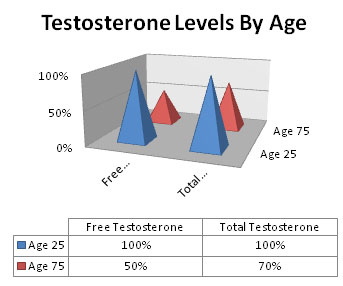What Are Free Testosterone Levels Ranges

Free testosterone levels for this hormone in a male should fall between a certain range in order for a man to feel his best. Here is a simple outline of what free testosterone level ranges should be according to the experts. Ranges will vary from clinic to clinic, but here are numbers from the Mayo Clinic:
- Testosterone levels in men from 30 to 40:
30 – 35 years: 1.51 – 18.57 ng/dL
35 – 40 years: 1.39 – 17.69 ng/dL
- Testosterone levels in men from 40 to 50:
40 – 45 years: 1.26 – 16.81 ng/dL
45 – 50 years: 1.14 – 15.93 ng/dL
- Testosterone levels in men from 50 to 60:
50 – 55 years: 1.02 – 15.05 ng/dL
55 – 60 years: 0.89 – 14.17 ng/dL
- Testosterone levels in men from 60 to 70:
60 – 65 years: 0.77 – 13.30 ng/dL
65 – 70 years: 0.64 – 12.42 ng/dL
What is free testosterone? This is the testosterone in the male body that is not bound to sex hormone binding globulin (SHBG) in the bloodstream. Free testosterone levels will decline faster than total testosterone levels. It is important to keep them both balanced in order to avoid feeling negative symptoms.
Free testosterone will decrease at a rate of approximately 50 percent from age 25 to age 75. That is faster than the decline of total testosterone, which drops at a rate of 30 percent from age 25 to age 75.
Keeping levels of testosterone balanced in the body will help to avoid the following symptoms:
| Low energy | Foggy feeling |
| Fatigue | Difficulty with concentration and focus |
| Loss of muscle | Forgetfulness |
| Weight gain | Depression |
| Low stamina | Anxiety |
| Low endurance | Irritability |
| Loss of bone mineral density | Agitation |
| Loss of sexual stamina | Mood swings |
| Poor immune system | Overall emotional instability |
| Difficulty healing from injury | Erectile dysfunction (ED) |
| Slow recovery time after working out | Low sperm count |
| Poor sleeping patterns | Weak sperm potency |
| Balding | Infertility |
| Thinning hair | Lack of sexual libido |
| Wrinkling skin | High cholesterol levels |
| Loss of memory | Risk for heart attack or stroke |
Many more issues can occur when free testosterone levels dip, but testosterone replacement therapy (TRT) can help and stop these problems.
How To Increase Free Testosterone Levels
When looking for the right way how to increase free testosterone levels, one should only use a clinic that is honest, forthright and has a great reputation and successful track record with testosterone replacement therapy. Nothing less should ever be accepted. HT Medical Center offers everything needed to boost low free testosterone levels in order to give a man back his great health and quality of life.
This is a chart to share what a client will need to do to get free testosterone level ranges corrected when they are not balanced:
- Call the clinic of choice for a free initial consultation with a knowledgeable and caring clinical advisor
- Get blood testing, a physical exam and share a medical history
- Doctors will diagnose low T if blood tests show low levels of testosterone in the blood
- The physician will then write a prescription for the correct injections at the right dosage. All will be shipped to the patient’s address
- Advisors will help with preparation and self administration of injections via telephone
- Doctors will medically supervise therapy
The following chart will show what are considered to be low, normal and high levels of free testosterone (according to research from the Mayo Clinic) to make it clear where a man should fall in the range. Remember; however, that these are only approximate ranges, as clinics will differ in their definition of what they consider to be optimal or normal free testosterone levels by age.
Free testosterone levels in men chart by age for easy understanding:
Age
|
Normal Free Testosterone Levels Average Range |
Low Free Testosterone Levels Average Range |
High Free Testosterone Levels Average Range |
30 – 40 |
1.51 – 17.69 ng/dL |
< 1.51 ng/dL |
> 17.69 ng/dL |
40 – 50 |
1.26 – 15.93 ng/dL |
< 1.26 ng/dL |
> 15.93 ng/dL |
50 – 60 |
1.02– 14.17 ng/dL |
< 1.02 ng/dL |
> 14.17 ng/dL |
60 – 70 |
0.77 – 12.42 ng/dL |
< 0.77 6.6 ng/dL |
> 12.42 ng/dL |















